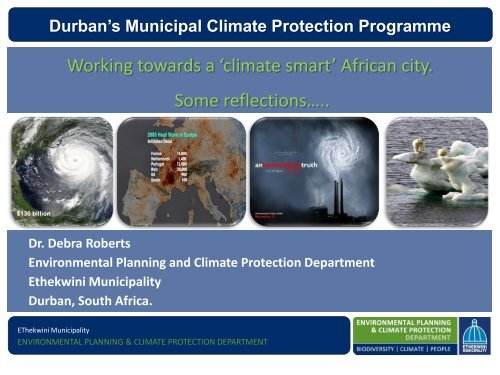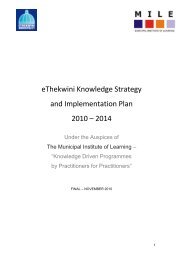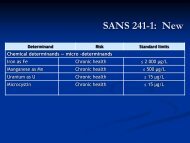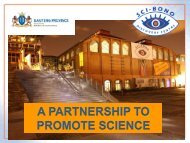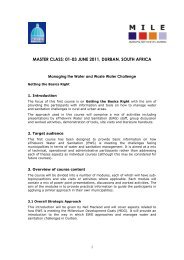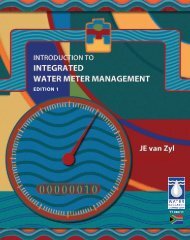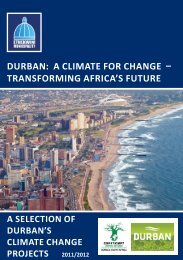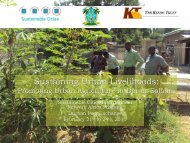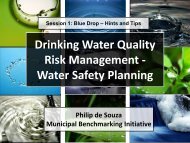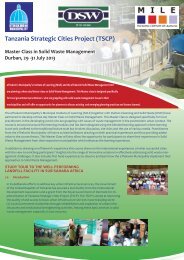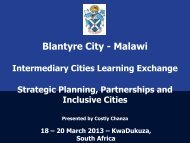Dr. Debra Roberts - MILE
Dr. Debra Roberts - MILE
Dr. Debra Roberts - MILE
- No tags were found...
You also want an ePaper? Increase the reach of your titles
YUMPU automatically turns print PDFs into web optimized ePapers that Google loves.
Durban’s Municipal Climate Protection ProgrammeWorking towards a ‘climate smart’ African city.Some reflections…..$130 billion<strong>Dr</strong>. <strong>Debra</strong> <strong>Roberts</strong>Environmental Planning and Climate Protection DepartmentEthekwini MunicipalityDurban, South Africa.EThekwini MunicipalityENVIRONMENTAL PLANNING & CLIMATE PROTECTION DEPARTMENT
The Local Context• Largest port and city on east coast ofAfrica: 2 300 km 2• Population: 3.5 million (highest level ofpoverty amongst major metros).• Budget: R31.8 billion (1 US$= >8 Rands)• 2/3 of the province of KwaZulu-Natal’sGDP• 34% unemployment• HIV/Aids - life expectancy of 47• Housing backlog: 408394 (1 July 2012)• Global biodiversity hotspot• The host city for COP17-CMP7EThekwini Municipality
Game Changer:perfect stormscenario.Potential to rollback Africa’sdevelopmentgains - past andfuture.
Municipal Climate Protection Programme (MCPP)Phase 1Impactassessment(2004-2006)2010-2050: annualcosts of adaptation$70-100 billion. 80%will be borne Phase by 2cities in thedeveloping worldMunicipal andcommunityadaptation(2005 - )Information sharing, networking and researchPhase 3Developing the toolkit(2007-2010)Mitigation: Energy Office (2008)Phase 4Mainstreamingclimateprotection(2007 - )• Assessing thelocal impacts ofclimate change• Carbon storageand sequestrationanalysis•Municipal AdaptationPlans•Communityadaptation Plans•Urban Management:Green Roof, eventgreening, sea-level risemodeling•Development ofan IntegrativeAssessment Tool•IntegratedDevelopment Plan (Plan1 Prog 6)•Institutional change•Mainstreaming intokey cityprojects/processes•International advocacyOngoingprogrammedevelopmentEThekwini Municipality
1Phase 1: Impact Analysisa) Assessing the local impacts of climate change (2004/05)Aim - To review the scienceof climate change:• How will Durban beaffected?• What responses arerequired to addressthese impacts?EThekwini Municipality
Threats of Climate ChangeChange to Climate Change Variable to Climate VariableHigher mean temperaturesExample of ImpactExample of Impact- Increased evaporation- Increased droughts- Decreased water availability- Extinction and changes in the distribution ofecosystems and speciesHigher maximum temperatures, more hot days and more heatwavesHigher minimum temperatures, fewer cold days and frost daysMore intense/heavy and variable rainfallIncreased mean sea level- Increased incidence of death (heat stress) andserious illness- Increased risk of damage to some crops(decreased food security)- Increased fire danger- Higher energy consumption- Increased risk to some crops- Increased pests and vector and waterbornediseases- Loss of tourism revenue- Increased flood, landslide and mudslides- Increased soil erosion- Increased pressure on disaster relief systems- Increased infrastructural damage- Salt water intrusion into ground water and coastal wetlands- Increased coastal flooding, and erosion particularly whencombined with storm surgesEThekwini Municipality
2Phase 2: AdaptationMunicipal Adaptation PlansHeadline AdaptationStrategy (05/06)Sectoral MAPsClimate Smart DMOSSIdentified :• municipal sectorsimpacted by climatechange.• type of adaptationrequired.• range of potentialadaptation options.• largely ineffective.EThekwini Municipality
2Adaptation: 2Municipal Adaptation PlansHeadline AdaptationStrategySectoral MAPs (08 –ongoing)Climate Smart DMOSS• Sector specific Municipal Adaptation Plans (MAPs) - pilot for other line functions.• Health: environmental; clinical; social development; communicable diseases.• Water: water & sanitation; coastal, stormwater & catchment management;coastal policy.• Disaster Management.•Basis for cost/benefit analysis to prioritise interventions based onhuman benefit, cost effectiveness and ecological viability.EThekwini Municipality
2Adaptation: 2• The Benefit Cost Ratio (BCR): does not rely on financial or economic measures(such as GDP growth) – benefit is determined by the number of people reachedand the impact on their well-being.• Socio-institutional interventions tend to provide the greatest economic efficiency,followed by ecosystem-based and lastly infrastructural interventions.consistentlyprovide the best BCRs across all four futures in the short, medium and long term.
2Adaptation: 3MunicipalAdaptation PlansHeadline AdaptationStrategySectoral MAPs1. Global biodiversity hotspot – Durban Metropolitan OpenSpace System (D’MOSS): 95 000ha. Provider of essentialecosystem services – state of foundation affects what youcan build on top!‘Climate Smart’ D’MOSS(07-ongoing)Ecosystem services2. Model future “bioclimatic envelops”. Use to review designof system and to improve resilience to climate change.Data inadequate.1. Long-term: address through research partnership with localuniversity.2. Short-term: reduce the non-climate stresses.1. Reduce habitat loss and fragmentation.2. Invasive alien species: strategy and implementationprogramme3. Various Town Planning tools.Socio-politicalsystemsEconomyGovernanceEThekwini Municipality
2Adaptation: 4CommunityAdaptation Plans‘Climate Smart’Communities(08/10)CommunityReforestationAdvancing Capacityto support ClimateChange Adaptation (ACCCA)• Pilot project in two poor, high riskcommunities: Ntshongweni (rural) andNtuzuma (urban).• Livelihoods analysis: community surveysand Participatory Rural Appraisal tools.• Food Security: replacement crops formaize.• Microscale agricultural watermanagement: water a key limitingfactor.EThekwini Municipality
Food SecurityFuture agricultural productivity (2046-2065)<strong>Dr</strong>yland Maize: initial projections were that maizeproductivity would be reduced to almost 0 t/ha.EThekwini Municipality
2Food Security• Phase 1: Test yields of potential new staplecrops (e.g. wheat, dry beans, pumpkins,madumbes, sorghum, sweet potatoes andcassava)• Crop trials (including maize) in two pilotcommunities, and at two sites to thenorth of the province (Empangeni andMakhathini).• Further impact assessment and outcome oftrials suggest that by shifting planting datesand providing irrigation it will be possible toensure maize productivity in the future.Ntuzuma – winter planting• Phase 2: Test social acceptability –community cookoff.• Phase 3: Conclusions and recommendations.Makhathini – summer plantingEThekwini Municipality
2) Community Based AdaptationCommunity AdaptationPlans‘Climate Smart’CommunitiesCommunityReforestation (08 -ongoing)• Durban: ‘Carbon Neutral’ 2010 FIFA SoccerWorld Cup. Footprint of 307 208 tCO 2 .ACCCA• Buffelsdraai Community ReforestationProject: buffer of a regional landfill site Willreforest 521 ha in total – replacing sugarcane. NGO partner.• 24 full time, 10 part time, 340 temporaryjobs and 685 “tree-preneurs” : grow andtrade indigenous trees.EThekwini Municipality
Tree-Preneur Cycleseeds planted &germinatedSeedlings grownand cared for untilready for saleFacilitatormeasures &counts treescredit noteissuedTree-preneurcollects seedTrees plantedby PlantingTeam atlandfillTrees taken tonursery atBuffelsdraaiTreescollected bytruckCredit noteexchanged forgoods at Tree StoreEThekwini Municipality
2) Community Based AdaptationCommunity AdaptationPlans‘Climate Smart’CommunitiesCommunityReforestation (08 -ongoing)• Roll out: Inanda Mt.250ha. 25 full time and 38temporary jobs and 138 “tree-preneurs”.ACCCA• 3 rd site for COP17-CMP7 ecological offset.Expanded ‘Community-Ecosystem BasedAdaptation’ (CEBA) concept. 200ha. 21 full timeand 80 temporary jobs and 160 “tree-preneurs”.• Adaptation advantages:• Rehabilitation of degraded forests.• Catchment management - water supplies.• Employment and upliftment ofcommunities.EThekwini Municipality
2Adaptation: 7Urban ManagementInterventionsGreen Roof PilotProject (08/12)Greening Durban 2010 (07/10)Sea Level Rise Modeling(07-ongoing)•Temperature and stormwater benefits•Biodiversity protection•Food productionGreen Guideline series:•Water and energy efficiency•Landscaping•Waste Management•Green Roof•Input into shoreline andcoastal management plans.•Projections of 30cm, 60cmand 100cmEThekwini Municipality
3Phase 3: Developing the toolkita) Integrative Assessment Tool (2007/10)• Partnership with Tyndall Centrefor Climate Change Research inUK. London case study.• Evaluate long-term city plansand policies against the impactsof climate change. Informmitigation and adaptationplanning.• Useful first step – but will needrefining. Indicative of thecomplexity involved inintegrating CC into urbanplanning.EThekwini Municipality
4Phase 4: Mainstreaminga) Institutional Change• Requirement for MCPP included within theIntegrated Development Plan (key cityplanning document)(from 2004).• Creation of the Climate Protection Branch(2007). Skills gap: difficulty in filling posts.• Creation of the Energy Office (2008).• Building a co-ordinated city wide climateprotection function• Climate Protection Branch: adaptation.• Energy Office: mitigation/ GHG reporting..• Coastal Policy: sea-level rise.• Disaster Management: DRRTransportation25%Commercial9%Government GHG contribution as a percentage ofthe EMA (with category breakdown)(2005/2006)Waste0.5%Government5%Residential17%Industrial44%EThekwini Municipality
4Phase 4: Mainstreamingb) Key city projects1. FIFA Soccer World Cup: “Greening Durban2010” campaign.• Goals:• Climate Neutrality – not able to achieve• Energy efficiency• Water efficiency• Sustainable Waste Management• Sustainable Transport Systems• Biodiversity2. Strategic Environmental Assessment:Spatial Development Plans/Safe OperatingSpace Study. Climate change will be includedas a key driver.307 208XEThekwini Municipality
4Phase 4: Mainstreaming3. UNFCCC COP17-CMP7. Durban 28 thNovember – 9 December 2011• “Durban Local GovernmentConvention: adapting to a changingclimate” 2-4 December 2011.• Partnership between EM, SALGA, SACN, DEAand ICLEI.• Key output: the Durban AdaptationCharter – partner to the Mexico City Pact.• Signed on 4-12-2011 and presented to HighLevel segment on 9-12-2011. 109 Mayorsrepresenting over 970 local governments from30 countries. 94% from global south.EThekwini Municipality
4Phase 4: Mainstreaming4. uMhlangane Catchment ProjectPurpose: To explore how a ‘business unusual’ approachthat encourages cross-sectoral planning and decisionmaking,stakeholder engagement and a focus on the city’snatural resources, can enhance efforts to managecatchments as key climate change adaptation tools withinthe municipality.Examples of current focus areas:• Coordination of cross-sectoral team• Biophysical and socio-economic assessment (baseline)• Ecosystem restoration for flood attenuation andstormwater management• Climate change responsive town planning• Water quality monitoring• Partnership with sister city (Bremen) – funding andknowledge exchangeEThekwini Municipality
X-cutCrosscutting: Information Sharing, Networking and Research• “Durban’s Climate Summit: local action for a resilientcity.” 28 May 2009. Mandate for the establishment of a“Durban Climate Change Partnership”. Work began in2010. Steering Committee established 2011. Put onhold August 2012.• National United Nations Framework Convention onClimate Change negotiating team. Used to raiseprofile of local level, urban adaptation.• IPCC Fifth Assessment Report 2014. Chapter 8, UrbanAreas, Chapter 12, Africa Working Group IIEThekwini Municipality


